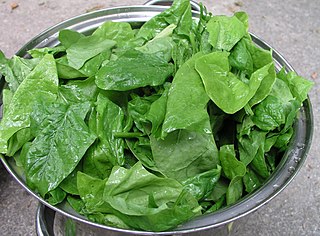Related Research Articles

Leaf vegetables, also called leafy greens, salad greens, pot herbs, vegetable greens, or simply greens, are plant leaves eaten as a vegetable, sometimes accompanied by tender petioles and shoots. Although they come from a very wide variety of plants, most share a great deal with other leaf vegetables in nutrition and cooking methods.
The BBCH-scale is used to identify the phenological development stages of plants. BBCH-scales have been developed for a range of crop species where similar growth stages of each plant are given the same code.
In biology, the BBCH-scale for beans describes the phenological development of bean plants using the BBCH-scale.
In biology, the BBCH-scale for beet describes the phenological development of beet plants using the BBCH-scale.
In biology, the BBCH-scale for bulb vegetables describes the phenological development of bulb vegetable plants, such as onion, leek, garlic and shallot, using the BBCH-scale.
In biology, the BBCH-scale for canola describes the phenological development of canola plants using the BBCH-scale.
The BBCH-scale for citrus is a classification system used in biology to describe the phenological development of citrus plants using the BBCH-scale.
In biology, the BBCH-scale for cotton describes the phenological development of cotton plants Gossypium hirsutum using the BBCH-scale.
In biology, the BBCH-scale for faba beans describes the phenological development of faba beans using the BBCH-scale.
In biology, the BBCH-scale for grapes describes the phenological development of grapes using the BBCH-scale.
In biology, the BBCH-scale for musaceae describes the phenological development of musaceae using the BBCH-scale.
In biology, the BBCH-scale for other brassica vegetables describes the phenological development of vegetables such as brussels sprouts, cauliflower and broccoli using the BBCH-scale.
In biology, the BBCH-scale for peanut describes the phenological development of peanuts using the BBCH-scale.
The BBCH-scale (potato) identifies the phenological development stages of a potato. It is a plant species-specific version of the BBCH-scale.
The BBCH-scale for root and stem vegetables identifies the phenological development stages of the root and stem vegetables such as carrot, celeriac, kohlrabi, chicory, radish and swede, using the BBCH-scale.
The BBCH-scale identifies the phenological development stages of solaneous fruit. It is a plant species specific version of the BBCH-scale.
The BBCH-scale (strawberry) identifies the phenological development stages of strawberry. It is a plant species specific version of the BBCH-scale.
The BBCH-scale (weed) identifies the phenological development stages of weed species. It is a plant species specific version of the BBCH-scale.
In biology, the BBCH-scale for leafy vegetables forming heads describes the phenological development of leafy vegetables forming heads, such as cabbage, chinese cabbage, lettuce and endive, using the BBCH-scale.
Cereal growth staging scales attempt to objectively measure the growth of cereals.
References
- Feller, C.; H. Bleiholder; L. Buhr; H. Hack; M. Hess; R. Klose; U. Meier; R. Stauss; T. van den Boom; E. Weber (1995). "Phänologische Entwicklungsstadien von Gemüsepflanzen: I. Zwiebel-, Wurzel-, Knollen- und Blattgemüse". Nachrichtenbl. Deut. Pflanzenschutzd. 47: 193–206.